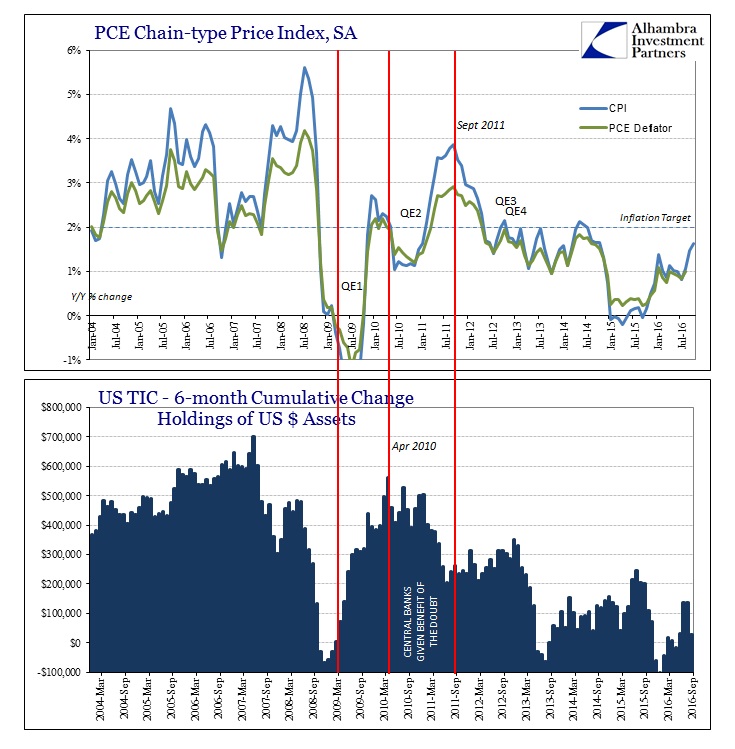Submitted by Jeffrey Snider via Alhambra Investment Partners,
It is an apparent contradiction to where we can describe a desperate money supply situation yet stock prices, in particular, are at all-time highs or at least outwardly unconcerned about all of it. This isn’t anything new, however, as noted last week where we may be witnessing the third or fourth iteration of the same repeating cycle. It was, after all, the S&P 500 registering a brand-new high in October 2007 more than two months after liquidity (“dollar”) problems were discovered to be widespread and systemic.
There aren’t any perfect or perhaps even good analogies by which to explain these differences, these periods where, as I described them, risk markets in particular convince themselves that the low rumblings of trouble are exclusively overseas or trivial concerns. That was 2013 and into 2014, a period that on more reflection feels a very apt comparison to what we find now. Stocks absolutely surged throughout 2013 even though the conditions that eventually made the “rising dollar” were obvious and apparent at that time.
One analogy I can make is that of an engine with a single piston that is misfiring, mistimed or maybe not properly seated in its cylinder so that you hear an audible and distinct knocking sound as the engine is running. That problem piston is the localized “dollar” problem that registers a perhaps ambiguous warning, one that can be disregarded since an engine, and thus your car (as the economy), will continue to run even with a misfire – for a time. The longer the piston remains off, the greater the strain it puts on the rest of them in both mechanical and efficiency factors. If it goes on long enough, you will be forced to deal with it and not by choice and not in a favorable outcome.

The way that “inefficiency” propagates throughout the “dollar” system is also complex and takes time to figure. In mid-2013, that “massive dollar warning” as I called it at the time took a full year to become the “rising dollar” even though it had in between crept up and into various market problems including interest rate swaps and especially overseas currencies. CNY, for example, turned lower in January 2014 which was an especially significant development especially as to how far this disruption might have by then progressed. It was just written off as China being China, entirely unrelated to US circumstances. Even the shocking dropoff in growth was totally set aside as something completely related to snow and cold.

But even by July 2014 as these seemingly “overseas” problems started to crop up in domestic issues, they were still largely ignored in places such as stocks. The economic stats were ambiguous (without calibrating for “dollars”), meaning that there wasn’t a clear progression easily established from “dollars” to markets to economy. That wouldn’t happen, of course, until late 2014 and early 2015, and even at this relatively late stage stocks and economists were unimpressed; the S&P 500 hitting and being close to new highs, eerily reminiscent of October 2007, all the way to around late May that year.
Beside the complexities that require time to feed disruptions through to widespread function, stocks have their own distinct sources of liquidity and funding that aren’t always tied to interbank conditions and what we find in global money markets. Not only have the corporations themselves been huge, non-economic buyers, so, too, have global central banks and not just of their own local stocks but also in a great many jurisdictions that have added huge positions in US equities. The same has held for sovereign wealth funds, as well as personal savings distributions here and abroad.
In other words, it isn’t until these separate sources are directly forced to confront these contradictions that new highs turn into waves of selling and liquidations. Liquidations are, after all, the combination of illiquidity plus selling; without the latter there isn’t much that will occur of any interest. It was that way in October 2007 as well as throughout 2013 and then again in the first half of 2015.
It is this repetition that gets overlooked because each time people want to believe that “it” cannot possibly continue any longer. People believe that either central banks will finally guess correctly given enough chances, or things will just improve because depressions have been banished by credentialed economists from the mainstream vernacular. And still the process repeats: overseas problems that are ignored in the almost-euphoria of central banks doing something “different” at least partly in response; the first triggers of doubt that those “overseas” problems might not be strictly overseas; more obvious data and prices that show festering problems becoming more widespread; further confirmation that economy as well as money and markets are being significantly affected; and finally more easily observed statistics or indications that leave no doubt. It is only close to the end of that evolution where the mainstream, including stocks, is finally confronted with its obliviousness.
In 2007, the process was greatly condensed by the speed at which “dollar” problems themselves progressed, as a matter of quick revulsion and then panic. In the “rising dollar”, it was spread out over a large period of time because the “dollar” itself was a function of banks slowly withdrawing resources not in a panic but in a series of calculated responses to the reverberations throughout “overseas” and back again. It wasn’t until early 2015 that it finally started to resemble a landslide.
The ability at which the “market”, largely stocks, as well as economists can rationalize these developments cannot be overstated. I had produced throughout 2015 an enlarging list of those excuses which proved to be a very good indication itself for this process going from strictly overseas “dollar” to blatant, global economic disruption:
1. Dollar doesn’t matter, indicates strong economy relative to the world
2. Dollar matters for oil, but lower oil prices mean stronger consumer
3. Manufacturing slump doesn’t matter, only temporary
4. Manufacturing declines are consumer spending, but only a small part
5. Manufacturing declines are becoming serious, but only from overseas
6. Maybe domestic manufacturing recession too, but the rest of the economy is strong
7. Rest of the economy might not be as strong as thought, but only an “earnings recession.”
By the time #8 appeared, which was growing acceptance that full-blown recession might be a very good possibility, it had been two years since the “dollar” first warned about the next global leg down. That difference, however, is important to keep in mind; 2014 was supposed to be the year that the global recovery was initiated, the long-awaited liftoff, but was instead beset by seemingly minor disturbances supposedly unrelated to the US as at least the “cleanest dirty shirt.” In truth, the US was just as dirty a piece of clothing as all others; the only actual difference was that by overlooking the grime the mainstream was able to wallow once more all over again in confirmation bias.
The fact that stocks are at record highs as the “dollar” disrupts still another time is as regular as the seasons. Stocks are fueled by hope which takes time for the “dollar” to disprove through first its own systems and then full economy; as it has time and again.



The post Haven’t We Done This Before? appeared first on crude-oil.top.
